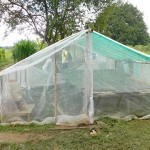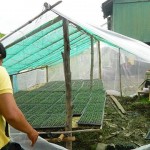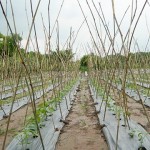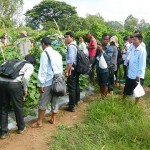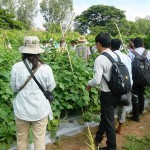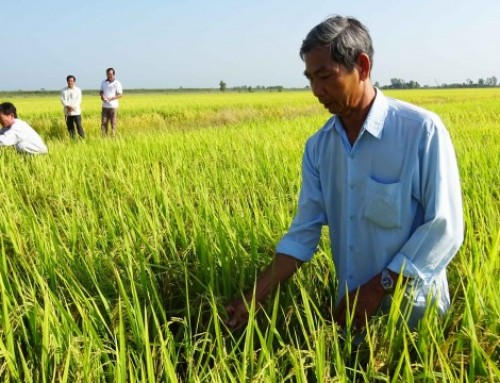In different shades of green agriculture

Public and private sectors in Cambodia give green agriculture a pat
A recent Cambodian-German forum received 146 attendees from both public and private sectors in Phnom Penh, which made it one of the biggest green events in Cambodia to promote the use of environmental friendly inputs for crop protection.
The participants comprised regulators, extension workers, researchers, entrepreneurs, and farmers from Cambodia and overseas. The 3rd National Forum on Regulation, Use and Trade of Biocontrol Agents (BCAs) in Cambodian Agriculture was held on 22-23 September 2016 to provide a platform to the relevant stakeholders to exchange and discuss the benefits in using the BCAs, and showcase the green agricultural success.
Highlights included a visit to three demonstration fields in Kien Svay district, Kandal Province about 90 minutes from Phnom Penh. Responsible by three private companies, each field grew different crops. Eco Agri Centre provided green inputs and technical supports to farmers at the cucumber demonstration plot, while Angkor Green took care of the sowing tomato trials, and Fertikal gave advices and supplies to farmers at the yard long bean demonstration trials.
Mr. Doeun Thuk, a farmer at the cucumber demonstration plot said the cucumbers grew better using Trichoderma when compared to his traditional practice.
“I would apply the Trichoderma again for the next crop season, said Mr. Thuk.
Mr. Tak Tok, a farmer at the tomato trial observed that with the use of biocontrol inputs mixed with compost the germination of sowing tomatoes seeds grew quick and looked healthy. Besides, the roots did not rot.
Mr. Chea Vanda, a farmer who took care of the yard long bean demonstration plot, said he was happy to see his crop growing well
“To get the same result, I will need to spray the Nitrogen chemical twice,” Mr. Vanda said.
The three demos started at different periods and each crop varied in terms of the productive stages. For the cucumber plot, it was planted on 15 August 2016 and took 38 days for the total productive stage. The farmers got 66 kg of cucumber for a two-time harvest. Yard long bean trial was transplanted on 2 September 2016 and took 21 day for the growing stage. The tomato plot was sown on 17 September 2016 and took seven day in the seedling stage.
The participants were divided into three groups consisting of 30 to 35 people and rotated to visit all the three plots.
The two-day forum consisted of presentations and discussions between the public and private sectors including a working group session for a Learning Alliance on Policies Supportive of Rice Integrated Pest Management which is a discussion among groups of farmers, companies, NGOs, and government agencies.
H.E Hean Vanhan, Deputy Secretary of State said at the forum that the main functions of BCAs consist of plant protection, soil fertility improvement, and pathogen. He furthered that BCAs regulations and products in Cambodia were quite limited because the country did not produce BCAs or chemical pesticides, but mostly imported them from foreign countries. The BCAs products could be registered only when they had gone through a laboratory and field experimentation.
At the forum Dr. Kean Sophea, a Deputy Director of Department of Horticulture and Subsidiary Crop talked about ‘Trichoderma’ which was fungal organism that controlled a variety of fungal and bacterial diseases which could help farmers produce better crops and have higher income while protecting the soil environment. The Trichoderma left no residues, dissolved excessive soil salts, and naturally provided a long-term immunity to crop and soil.
In addition, Mr. Bun Saborn from Netherlands Development Organization (SNV), a non-profit international development organization presented the result of BCA trials on the insect control by using Pheromones and Bacillus Thuringiensis. The fields were implemented in Stung Treng and Preah Vihear provinces in Cambodia and the target crops were yard long bean and green mustard. There were five different types tested in each field: BT (Xentari), BT (strain 911), Neem liquid (oil), Farmer practice, and Check (apply nothing). BT (Xentari), BT (strain 911), Neem liquid (oil) are BCAs. It was found that the fields using BT (Xentari) and BT (strain 911) had higher yields than the others (Table 1).
Table 1: Result of experimentation
| Rep | Average Yield in two provinces | |
| Yard Long Bean (T/ha) | Mustard (T/ha) | |
| Check | 16.88 | 18.61 |
| BT -Xentari | 17.21 | 25.75 |
| BT-Strain 911 | 17.72 | 26.44 |
| Farmer’s practice | 16.20 | 22.38 |
| Neem oil | 15.99 | 23.39 |
Moreover, Mr. Saborn did a comparison between Pheromone Lures for Spodoptera litura, and plutella xylostella and Check. As seen in the Table 2, an average yield of the yard long bean trials using the BCAs was higher.
Table 2: Result of experimentation
| Rep | Average Yield in two provinces | |
| Yard Long Bean (T/ha) | Mustard (T/ha) | |
| Check | 9.52 | 15.53 |
| Pheromone lures for Spodoptera litura | 11.33 | 16.32 |
| Pheromone lures for plutella xylostella | 11.20 | 17.03 |
Mr. Trinh ViSieu from ASEAN Sustainable Agrifood System project in Vietnam presented an application of Metarhizium against brown plant hopper. Metarhizium is an entomopathogenic fungus that was used as control agents against insect pests. They were naturally occurred in the field, and could be found on infected insects.
In his study Mr. ViSieu compared among Metarhizium, Chemical Control and Farmer’s Practice, and the result showed that ‘Metarhizium’ was an effective control agent against brown plant hopper and rice bugs, and significantly had less damage to natural enemies such as mirid bug and spiders. Also, Metarhizium had prolonged effect against brown plant hopper and was not likely to cause brown plant hopper resurgence. It could be used as preventive and curative measures.
There were five private companies displaying their products, mainly organic fertilizer, bio pesticide, drip irrigation, seeds, and training books related to agriculture at the forum.
Ms Lim Lili, a farm manager at Pepper Hill Farm in Cambodia said she found the forum very interesting.
“I gained a lot of knowledge on the theory concept of BCAs and practical sides of how to germinate tomato seeds, grow yard long bean and cucumber, and apply Trichoderma and bio fertilizer and pesticide during the field visit. Also, the effectiveness of BCA is impressive. It is really good not to use chemical,” she said.
Ms Lili plans to share what she learnt from the forum to her colleagues and other partners.
The event was launched in cooperation between the Ministry of Agriculture, Forestry and Fisheries (MAFF), the International Rice Research Institute (IRRI) through the “Development of Ecologically based Participatory Integrated Pest Management Package for Rice in Cambodia or” (EPIC) project and the German International Cooperation (GIZ) via ASEAN Sustainable Agrifood Systems (ASEAN SAS) Project.
[wpdm_package id=’8225′]
By Saody So and Rojana Manowalailao, ASEAN Sustainable Agrifood Systems















